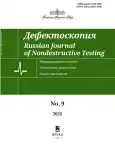DEFECTS SIZE MEASUREMENT AND PHYSICAL LIMITATIONS OF DIGITAL DATA PROCESSING IN ULTRASONIC FLAW DETECTION BY ECHO AND DIFFRACTION METHODS
- Authors: Mogilner L.Y.1,2, Stekolshchikov Y.A.1
-
Affiliations:
- Bauman Moscow State Technical University
- Federal State Autonomous Institution «Scientific and Educational Center «Welding and Testing» of BMSTU
- Issue: No 9 (2025)
- Pages: 32-44
- Section: Акустические методы. По материалам XXV Петербургской научно-технической конференции УЗДМ-2025 «Методология ультразвукового контроля: фундамент и современные надстройки», посвященной 100-летию А.К. Гурвича
- URL: https://bakhtiniada.ru/0130-3082/article/view/308428
- DOI: https://doi.org/10.31857/S0130308225090042
- ID: 308428
Cite item
Abstract
The article notes that manufacturers and suppliers of ultrasonic flaw detectors usually focus on the sensitivity of the equipment, but pay little attention to the error which the linear dimensions of defects can be measured with. Examples of representing sections with defects in the form of acoustic B-scans are provided, and it is shown that these images have changed little over the past 60 years, despite the fact that the level of technology and signal processing have developed significantly during this time. It is noted that the physical principles that underlie ultrasonic flaw detection and the accumulated practical experience of its application show that at present the dimensions of defects can be measured no more accurately than with an error of 1 mm. Therefore, it would be more accurate to talk not about measuring of defects height in the cross-section of welded seams, but about assessing this height using ultrasonic flaw detection methods. At the same time, the article shows that it is possible to qualitatively assess the defect height change by fractions of a millimeter. For this purpose, in addition to the traditionally used time sweeps of signals (A-scans) and amplitude spectra, it is advisable to pay more attention to the analysis of phase spectra of signals received from products. The results of an experimental assessment of the influence of weak anisotropy of the material on the shape of the phase spectra of bottom pulses are presented. The calculations performed showed that the phase spectra also change significantly more than other characteristics of the recorded pulses with an increase in the height of defects in the cross section of the weld. This conclusion also applies to cases where the height of the defect does not exceed the length of the ultrasonic waves used
About the authors
Leonid Yuryevich Mogilner
Bauman Moscow State Technical University;Federal State Autonomous Institution «Scientific and Educational Center «Welding and Testing» of BMSTU
Author for correspondence.
Email: mogilner@mail.ru
Russian Federation, 105005 Moscow, 2 Bauman str., 5;
105005 Moscow, 2 Bauman str., 5
Yaroslav Alexandrovich Stekolshchikov
Bauman Moscow State Technical University
Email: ystekolshhikov@mail.ru
Russian Federation, 105005 Moscow, 2 Bauman str., 5
References
- Gurvich A.K. Ultrasonic flaw detection of welded joints. State Publishing House of Technical Literature. Ukrainian SSR, 1963. 228 p.
- Ginzel E. Ultrasonic Time of Flight Diffraction. Waterloo, Ontario, Canada: Eclipse Scientific, 2013. 249 p.
- Coulder A. Full Matrix Capture and Total Focusing Method: The Next Evolution in Ultrasonic Testing // Materials Evaluation. 2018. No. 76 (5). P. 591—597.
- Access mode: https://acsys.ru/?ysclid=mahslmksl9448836670; access date 10.05.2025.
- Access mode: https://ets-ndt.ru, materials from the website https://evidentscientific.com/en/; access date 10.05.2025.
- Non-destructive testing. Ultrasonic methods. Digital coherent technologies. Defectometry / Edited by A.Kh. Vopilkin. Moskow: Publishing House “Spectrum”, 2025. 640 p.
- Kanevsky I.N. Focusing of sound and ultrasonic waves. Moskow: Publishing House “Nauka”, 1977. 336 p.
- Shevaldykin V.G., Samokrutov A.A., Smorodinsky Ya.G. Terms of ultrasonic testing with phased arrays and what they mean // Defectoskopiya. 2018. No. 9. P. 31—40.
- Mogilner L.Yu., Syasko V.A., Shikhov A.I. Modeling Defects in Ultrasonic Nondestructive Testing: State-of-the-Art and Prospects // Defectoskopiya. 2024. No. 5. P. 13—35.
- Aleshin N.P., Baranov V.Yu., Bezsmertny S.P., Mogilner L.Yu. Influence of anisotropy of elastic properties of rolled products on the detection of defects in ultrasonic non-destructive testing of large diameter pipes welding // Defectoskopiya. 1988. No. 6. P. 80—86.
- Volkova L.V., Muravyova O.V., Muravyov V.V., Buldakova I.V. Device and methods for measuring acoustic anisotropy and residual stresses of metal in main gas pipelines // Instruments and methods of measurement. 2019. V. 10. No. 1. P. 42—52.
- Mogilner L.Yu., Skuridin N.N., Studenov E.P. Monitoring the stress-strain state of metal structures at site facilities for pipeline transportation of oil and petroleum products: status and prospects // Oil industry. 2019. No. 11. P. 144—148.
- Kharkevich A.A. Spectra and analysis. Moskow: State. Ed. physics and mathematics literature, 1962. 236 p.
- Kachanov V.K., Kartashev V.G., Sokolov I.V., Shalimova E.V. Methods of signal processing in ultrasonic flaw detection. Moskow: Publishing house MEI, 2010. 220 p.
- Badalyan V.G., Bazulin E.G., Vopilkin A.Kh., Kononov D.A., Samarin P.F., Tikhonov D.S. Ultrasonic flaw detection of metals using holographic methods / Ed. A.Kh. Vopilkin. Moscow: Mechanical Engineering, 2008. P. 368.
- Ermolov I.N., Lange Yu.V. Non-destructive testing: Handbook / Under the general editorship of V.V. Klyuev. Moskow: Mechanical engineering. V. 3. Ultrasonic testing, 2004. 853 p.
- Sergienko A.B. Digital signal processing: a tutorial. S.Petersburg: BHV-Petersburg, 2011. 768 p.
- Aleshin N.P., Mogilner L.Yu. Analysis of the elastic field of ultrasonic waves scattered by a cylindrical reflector // Defectoskopiya. 1984. No. 6. P. 3—13.
- Mogilner L.Yu., Smorodinsky Ya.G., Tishkin V.V. Volumetric reflectors using to adjust ultrasonic testing parameters // Defectoskopiya. 2024. No. 10. P. 3—15.
- Ermolov I.N., Vopilkin A.Kh., Badalyan V.G. Calculations in ultrasonic flaw detection. (Quick references book). M.: NPC NK “Echo+”, 2004. 109 p.
Supplementary files









